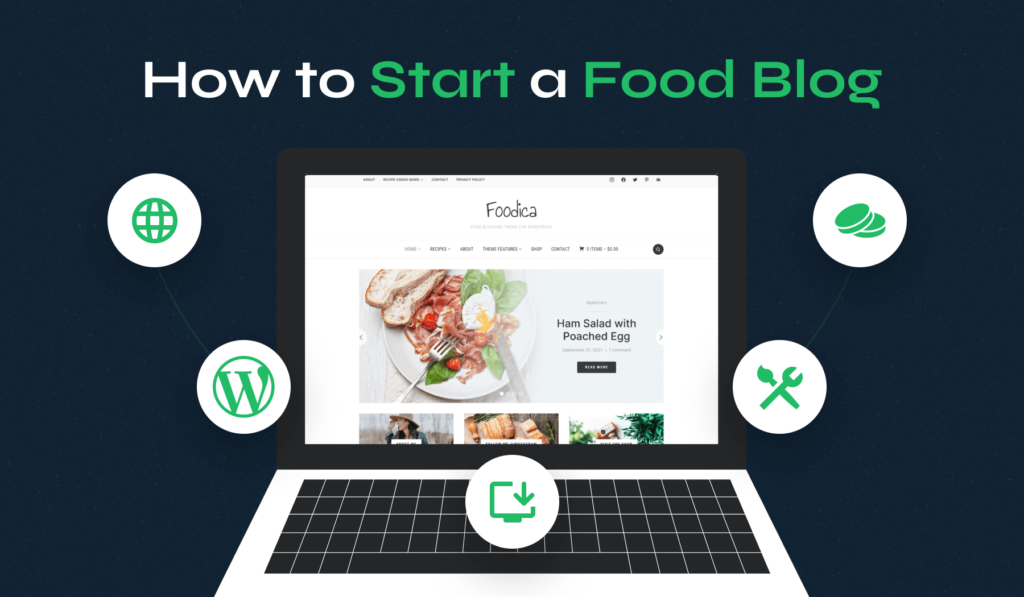
Of all the passions that can be turned into a money-making, rewarding, and fulfilling career, food blogging stands out as one of the best possible choices. Food blogging can mean anything from sharing your recipes with the world to sharing your thoughts about different restaurants from all over the world.
So, being a food blogger comes with a lot of advantages ranging from the delicious products you will delight yourself with to the possibility of earning quite serious money while doing what you love. So, how to start a food blog? Well, creating a food blog requires a very particular skill set, a unique view, and a lot of dedication. We are here to teach you everything you need to know.
8 Steps to Start a Food Blog
Creating a food blog from scratch is as easy as one two three. The real challenge is turning it into a successful business. You should know right off the bat that making a food blog and turning it into a success story is a long-term project. Nothing is going to happen overnight, and your success is not guaranteed.
To improve your chances of success, you should follow the steps below to do things right and set a solid base for your future business.
- Finding Your Niche in the Food Blogging World
- Crafting a Memorable Name and Securing Your Domain
- Setting Up Your Food Blog: Technical Essentials
- Designing Your Blog: User Experience and Visual Appeal
- Content is King: Planning and Creating Engaging Posts
- Leveraging Social Media and Other Platforms for Growth
- Monetizing Your Passion: How to Make Money from Your Food Blog
- Analytics and Improvement: Understanding Your Audience
Read below to find details about each step.
1. Finding Your Niche in the Food Blogging World
The importance of finding the right niche in the online culinary world is something you should never downplay. You should seriously take into consideration the fact that these days, when the online environment is more competitive than ever (the food blogging world is no exception), slacking off or not taking seriously the choice of niches can cost you your success.
Think about it this way: if you decide to open an online store, do you think you’ll have more success as a general store owner or by specializing in a particular type of product? With competitors like Amazon, eBay, and dozens of other giants, your chances of success with a general store are quite slim. If you find your niche and open an online store targeted to a specific group of buyers (like hobby products for example), you are a lot more likely to succeed.
That should be the same thought process when it comes to starting a food blog. By now, you already probably know that there are some pretty successful food blogs out there, which are grabbing a big slice of the food-related online traffic.
To succeed, you will need to find what’s missing and focus on that. For example, if you like a particular type of cuisine, that is where you should start. Creating a food blog focused on Sicilian dishes is going to be a lot easier than succeeding with a blog dedicated to Italian food in general.
Yes, finding your niche can be difficult. Here are some tips to follow for identifying niches more easily and effectively.
- Personal Passions: Your culinary interests and expertise are probably the most relevant and decisive factors to consider. Are you drawn to specific regional cuisines, vegetarian options, baking delights, or healthy options? Start with what interests you.
- Market Gaps: Identify areas of food blogging that lack strong representation. You could specialize in vegan cuisine, unique ethnic dishes, or innovative meal prep techniques.
- Audience Appeal: Consider the preferences of your target audience. Who do you think you will be providing relevant content to? Do you, perhaps, want to target young mothers who are struggling to find the right balance between eating healthy and spending less time in the kitchen? In this case, your segment will appreciate recipes for quick meals or weekly meal plans.
Of course, instructions only tell part of the story. Here are some very successful niche food blogs, so you can see what you could start creating for yourself.
- Piping Pot Curry: Food blog dedicated to ethnic cuisine (Indian), with a focus on making things simple by using modern tools
- The Bettered Blondie: Having fought obesity for most of her life, Sara decided to journal her adventure of becoming a better version of herself. From her gastric bypass surgery to recipes focused on various diet types (gluten-free, low-carb, dairy-free, etc), there is a lot for people to learn from her journey.
- The clean eating couple: Food blog dedicated to healthy choices, with a focus on quick, easy, and delicious recipes that can be done by anyone with minimum effort
There is quite a lot for you to achieve in the online culinary world if you take the right course of action and stick to a well-thought-out plan. And everything needs to start with figuring out the niche you should start working in.
2. Crafting a Memorable Name and Securing Your Domain
The next important thing is choosing a name for your site. This needs to be easy to remember, catchy, and relevant to your niche. Whether it’s clever wordplay or something rather straightforward, you will need to consider all the things that go into choosing a brand name.
- Keep it short and relevant. The shorter your name is, the easier it will be for people to remember
- Make it easy to spell. For people to be able to remember and associate your blog with the specific niche you are trying to attack, you need to make sure your blog’s name (and therefore your URL) is easy to spell.
- Don’t be too professional. Using specific jargon might be tempting, but your target audience is likely not as involved in the culinary world as you are. Make things easy for them.
- Try to stand out and be original. Having a unique name will make you stand out from the crowd and therefore give you a competitive advantage.
Now that you have your brand name, it’s time to start looking for a domain for your website. Buying a domain name is quite an easy task these days. There are several registrars you can choose from, but for the sake of this article, we will focus on Namecheap.
To buy a domain from namecheap.com, you will need to follow a couple of easy steps:
1. Access namecheap.com and start searching for your domain name.
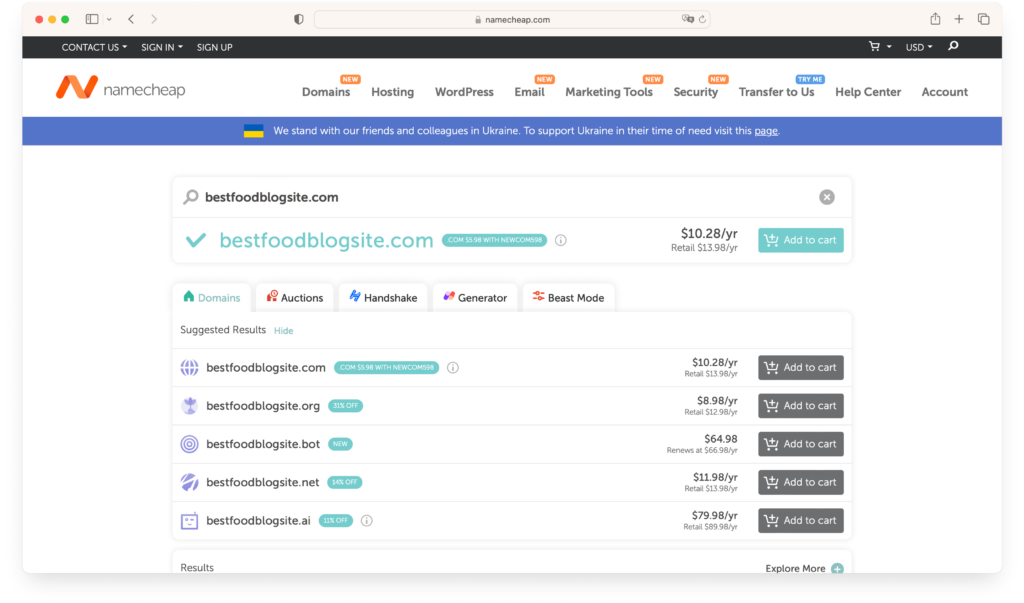
2. Once you find the right domain, click the Add to cart button next to it.
3. You can now visit your cart and review your order. You can choose the period for which you will need to register your domain (usually 1 year is the default, but you can pay in advance for more).
Select additional services if needed (privacy protection, mail services, etc)
When you are happy with your selection, click Confirm Order.
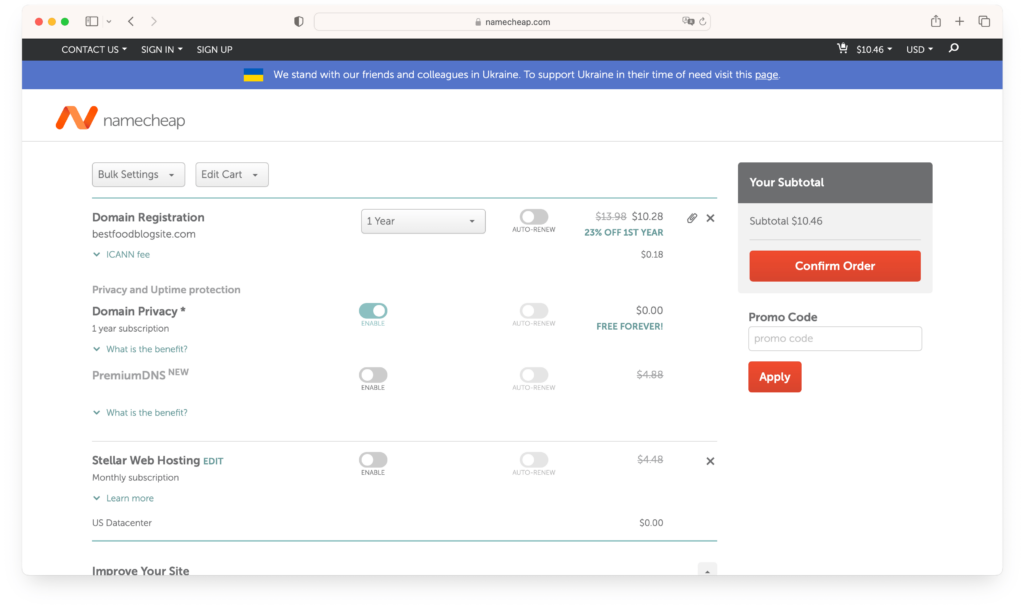
4. This will take you to a new screen where you will need to create your Namecheap account or log in to your account if you already have one.
5. Once you are logged in, select your preferred payment method and place your order by clicking on Pay Now.
In a couple of minutes, you will receive your configuration data via email as well as your confirmation.
From your Namecheap account, you can manage your domain settings, configure DNS records, and set up different other aspects of your future website.
If you also chose Namecheap as your hosting provider, you can now start setting up your hosting via cPanel and start configuring your website.
While this process is clearly a simple one, this is actually where the work really starts for you and your food blog.
3. Setting Up Your Food Blog: Technical Essentials
Creating your food blog involves everything from designing your site to choosing your theme or plugins.. So, what are the technical prerequisites for this whole process?
Choose a Hosting Provider
It all needs to start with choosing your hosting provider. This choice can impact your site’s performance and, in turn, its success in the future. So, making a good choice now can save you a whole lot of trouble later.
One thing you should know is that there are a huge number of possible choices when it comes to hosting. There are several factors you will need to consider though before deciding on a particular hosting provider.
Choose a hosting provider that is reliable and has a good reputation for being able to provide good performance and uptime. You will possibly run into some kind of trouble that will require outside help. You should be able to rely on the hosting provider to provide you with the right help when you need it.
Last but not least, the easiest and most commonly seen way to build your food blog is through WordPress. Therefore, you should use a hosting provider that offers easy WordPress integration and WordPress-specific setup processes.
While there are several top choices available online, our recommendation goes out to Siteground. This provider checks all the right boxes and provides a very high-quality level of service at a decent cost.
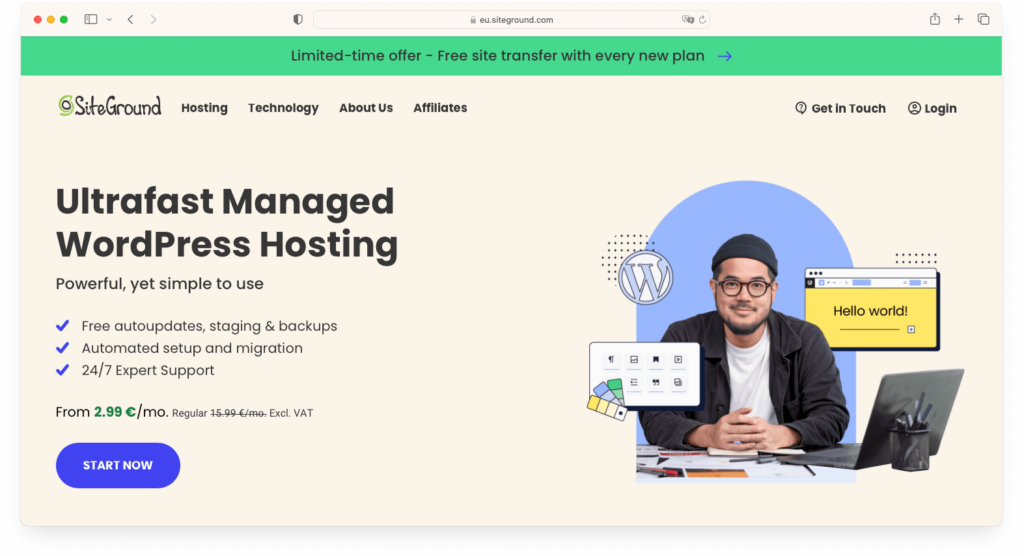
Select the Right Blogging Platform
There are several choices available for bloggers in terms of blogging platforms or site-building solutions. Many of them offer amazing, complex, and easy-to-use solutions. The top choices are, generally, the ones below:
- WordPress
- Wix
- Weebly
- Drupal
- Squarespace
Each comes with its own advantages and drawbacks, but the general consensus is that WordPress is usually the most versatile solution out there. It is by far the most popular and offers the most customization options (from themes to plugins and design options).
With WordPress, everything is made easy. From the initial setup to building your site, and managing it for years and years, WordPress is a great solution for beginners and advanced users as well.
Designing your WordPress website is a simple task if you choose the right theme, posting new content is simple and straightforward, and even setting up more complicated performance or security plugins can be easily done by beginners. Your main focus will remain on the content you post rather than wasting time and energy learning to manage a complicated site.
Choosing a Theme for Your Food Blog
One thing you should know is that theme directories provide countless options when it comes to WordPress themes that can be used for food blogs. How you choose the theme will influence the site’s design, functionality, performance, and ultimately, success. No pressure, right?
Well, there are some important decisions ahead. You will need to find a theme that hits the sweet spot in terms of balancing design and functionality. Obviously, an aesthetically pleasing website is more likely to be successful. But you will also need to make sure that your blog is functional and that it follows all the relevant guidelines, especially in terms of SEO.
Because your time is more relevant when it is spent working on your content, developing recipes, or sharing your knowledge with the world, we recommend you choose the Foodica PRO theme for your food blog. It is packed with useful features, comes with more than enough customization options, and provides pretty much everything you could possibly need for your food blog.
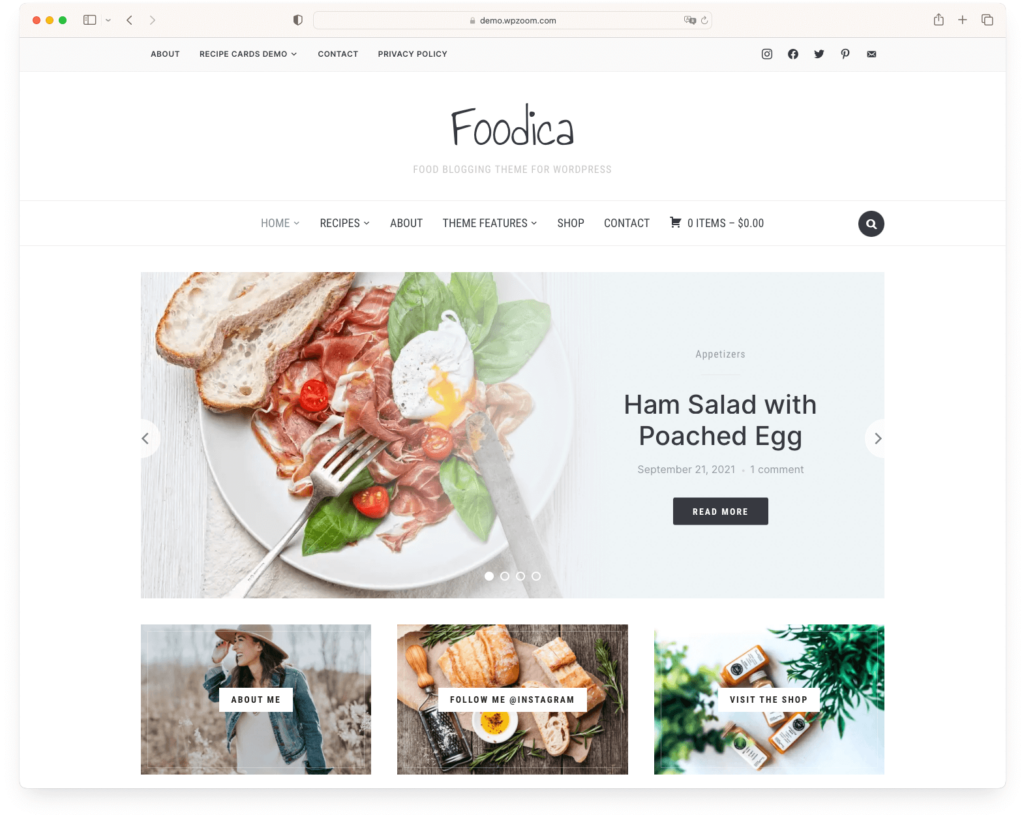
Here are some important key details you should know:
- Foodica PRO comes with built-in support for the Block Editor
- Provides Recipe Index Templates
- Offers 10 different color schemes
- Provides Elementor templates
- It is a quick, performant, and reliable lightweight theme
- SEO-friendly
Of course, if this is not up to your standards or you are simply looking for something different, there are some other choices for you:
Once you decide which theme is the right one for you, you will also need to go through the actual customization phase with your site, but more on that later.
Choose a Recipe Plugin
Another thing that is an absolute necessity for your food blog is having a good recipe plugin. These little wizards are great for making things as easy and convenient for your site while offering a great reading experience for your visitors.
Our top recommendation is, without question, Recipe Card Blocks. Here’s why:
- It works with the Block Editor
- It works with Elementor
- Offers multiple styles
- It offers a Schema Markup for structured data integration
- Easy to write recipes, with ingredients, directions, and even nutrition facts.
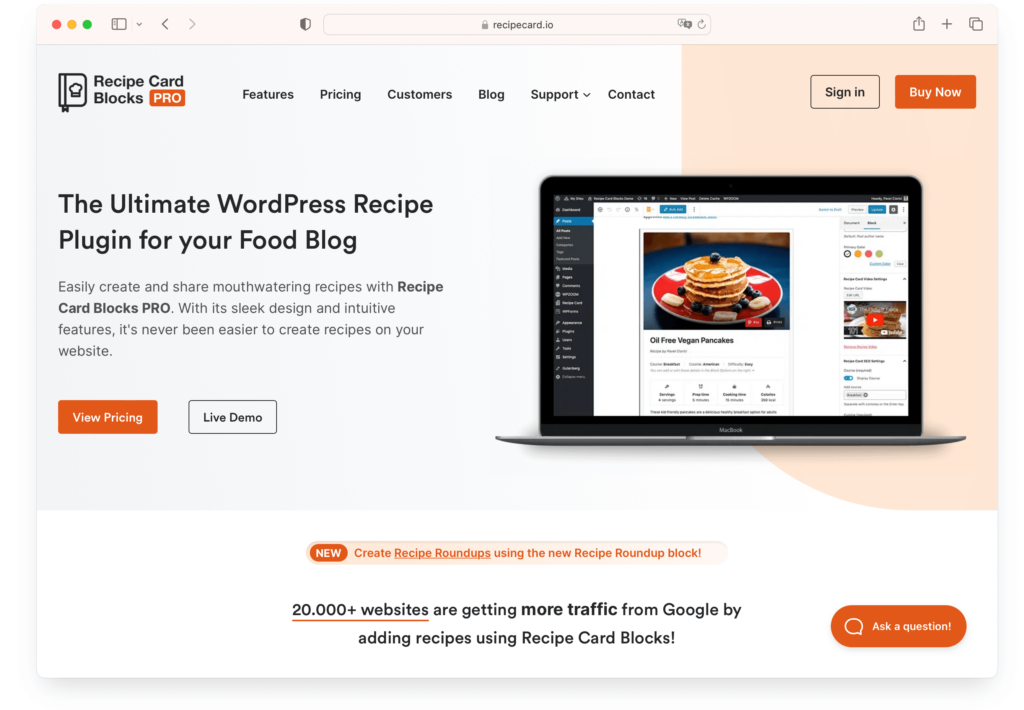
This will make your site more easily crawled by search engines and will make it a lot easier for Google to index. Therefore, it will rank higher and will perform better SEO-wise. You will be able to take advantage of a series of benefits if you use a dedicated recipe plugin, especially if you choose Recipe Card Blocks.
4. Designing Your Blog: User Experience and Visual Appeal
How you design your site does influence its success to a certain extent. The first impression always matters. Your content may be perfect and you could provide the best recipes that can be found online. But if your website needs a certain something in terms of appearance, you risk losing visitors even before they get to judge the quality of your content. That same thing can work the exact opposite way. Too many design elements can hinder your visitors’ experience.
There are some important things you need to take into consideration when designing your food blog.
- Your site needs to be user-friendly. Your visitors need to be able to find the information they need as easily as possible. There is no need for overcomplicated designs. After all, people come to your platform for advice more than anything. That is what they are looking for, not outrageous pieces of web design. Another thing you need to take into consideration is that many of them will also be actually cooking while reading your recipes. That means that the text needs to be as visible as possible, and the site needs to be as easily navigable as possible, even with dirty hands.
- You need good pictures. High-quality images are, in part, going to be responsible for your site’s success. The reason is simple: if people like the products they see, they are more likely to try and make them themselves, and/or return to your site for more. Food photography is, without a shred of a doubt, an art. Luckily, it is an art you can master by simply following a couple of best practices.
- Use natural light whenever possible for food photography. It enhances the colors and textures of the food and reduces harsh shadows.
- Pay attention to composition. Consider the rule of thirds, leading lines, and framing to create visually appealing images.
- Choose backgrounds and props that complement the food without being too distracting.
- Capture the details of the food, such as textures, garnishes, and drizzles.
- Use images to tell a story about the food. Show the ingredients, preparation process, and the final plated dish to engage your audience
5. Content is King: Planning and Creating Engaging Posts
The way you create your content is, ultimately, the most important thing of all. And, even though your impulse might dictate (especially when you are getting started) that you need to post a lot of content right away, the truth is that you should invest a lot more time in creating your strategy than developing your content in the beginning.
That being said, there are some things you need to focus on while thinking ahead. You should establish right off the bat how much time you can invest in this blog. Depending on your answer, you will need to create your content calendar, keeping in mind what your posting frequency will be. Whether you decide to post a new article daily, every week, or even twice a month, you will have to remain consistent with this frequency.
Of course, you will also need to diversify your content to a certain extent. Even if your specialty is, for example, soups, you can probably imagine that your success is going to be limited with a food blog dedicated entirely to soups. Whether it’s recipes, how-to articles, personal stories, or product reviews for kitchen appliances, the important thing to remember is that you need to expand your area to a certain extent.
Another thing to remember is that your content will not only be seen by humans. Your site will be constantly crawled by search engines, and the way you present yourself will help them decide where you will rank on certain keywords. That being said, your content will need to follow some rather strict guidelines to rank well on the keywords you want to rank on to get the traffic you need.
6. Leveraging Social Media and Other Platforms for Growth
Social media is a great way to promote your blog. Regardless of how you choose to promote yourself, posting on social media platforms can be a hugely successful strategy for bringing traffic to your site.
If you choose to create video content, you can generate lots of traffic with YouTube, TikTok, Facebook reels, Snapchat, and other platforms.
If writing is your thing, go for it on Reddit, or do some content marketing by answering questions on Quora.
If you want to make a splash with your photography skills, choose Instagram, Facebook, or even Pinterest.
Regardless of the way you decide to take advantage of the power of social media, the important thing to remember is that there are endless possibilities if you put the work in and do your research properly.
Building your own community is going to be essential nevertheless. You can do it by encouraging your visitors to subscribe to your newsletter. Another way is to choose to create for example a Facebook group for your fans. Regardless, it is important to stay in touch with your visitors and try to engage with them as much as possible.
WPZOOM offers specialized social media tools to enhance social media integration:
- Social Icons Widget: A simple yet powerful tool for adding social media icons to your website, linking directly to your profiles.
- Instagram Widget: It allows you to display your latest Instagram posts directly on your website.
7. Monetizing Your Passion: How to Make Money from Your Food Blog
Once your blog is off the ground and starts getting some traffic, you can start implementing monetization options.
There are multiple ways for you to monetize the traffic you get, and each comes with its advantages and drawbacks. While this is clearly a subject that can only be covered in several articles, here are some ideas for how you can monetize your blog with relative ease and great results:
- Display ads. Whether you choose AdSense or another ad network, displaying ads is the quickest and easiest way to start making some money with your blog.
- Affiliate marketing. With the right audience and well-designed affiliation strategies, you can end up making quite a lot of “dough”. Whether you promote kitchen appliances, tools, or other food-related products, as long as you promote quality products you can personally endorse, you will certainly generate some sales with the right audience.
- Sponsored content. With the right strategy and well-thought-out partnerships, you can generate a good and sustainable income with sponsored content.
- Digital products. Selling online courses, digital recipe books, subscriptions, or ebooks targeted to your own audience can be a great strategy for monetizing your blog and the traffic it gets.
While there are countless other ways for you to generate income with your food blog, these are generally the most common and accessible strategies.
Ideally, you would start promoting only the things you truly believe in. For example, if you are particularly happy with a kitchen appliance you use, you can look for ways to make some money by promoting it. You shouldn’t, however, recommend products you haven’t tested yourself.
8. Analytics and Improvement: Understanding Your Audience
You need to know that creating a food blog means accepting that your work never ends. It requires constant improvement, development, regularly renewing your content, and adding more info where needed.
Tools like Google Analytics and Google Search Console simply cannot miss from your toolbox. To be successful, you will need to always be one step ahead of your competition. And all that only begins with truly knowing and understanding your audience.
Google Analytics can provide you with extremely valuable data about your audience. From age, demographics, user locations, and even behavior, you can learn a whole lot about your readers and adjust your content strategy accordingly.
Conclusion
The process of learning how to start a food blog may seem overwhelming upon reading this article. One thing you need to understand is that all the information we provide will become useful in various stages of the process.
Creating a food blog doesn’t happen overnight, and you won’t need to do everything at once. There is a lot to get done, but there is also a lot of time to get it done, and the rewards will start coming if you do things right.
As long as you follow the most important steps and respect the process, you should have a quality product on your hands in no time. To recap, the most important things are:
- Finding your niche
- Choosing a catchy and relevant name, buying a domain and hosting
- Creating a quality website using the Foodica PRO theme and the Recipe Card Blocks plugin
- Mastering food photography
- Writing top-quality, SEO-friendly content
- Leveraging the power of social media
- Monetizing your blog
- Keeping your blog relevant and updated
With the right approach and these relevant tips for starting a food blog, you can make your dream of having a food blog come true with relative ease.


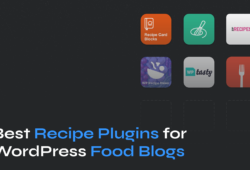
January 15, 2023 7:11 pm
Good afternoon,
Does your company assist with creating a website for WordPress? Or am I only purchasing themes and plugins?
Pebbles
April 13, 2023 9:25 am
Pebbles,
We can only assist you with services like installing WordPress and our themes on your website.
https://www.wpzoom.com/wordpress-services/